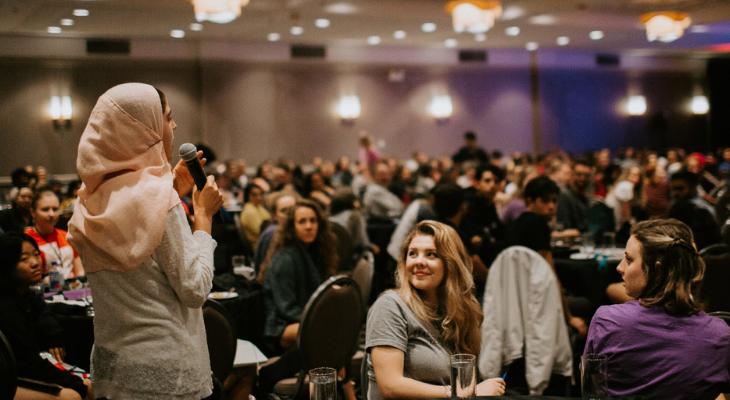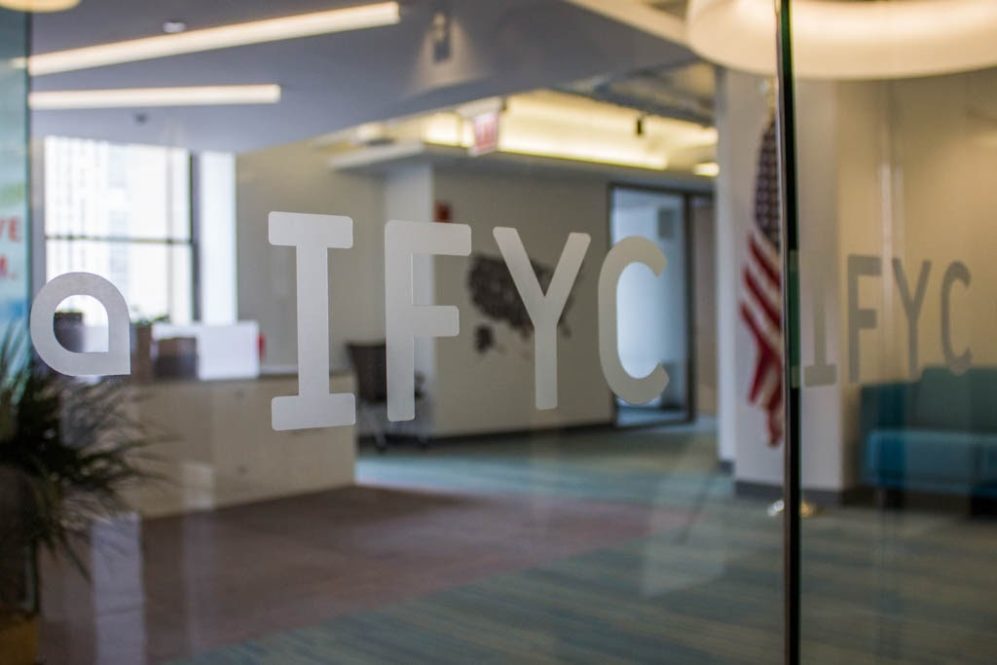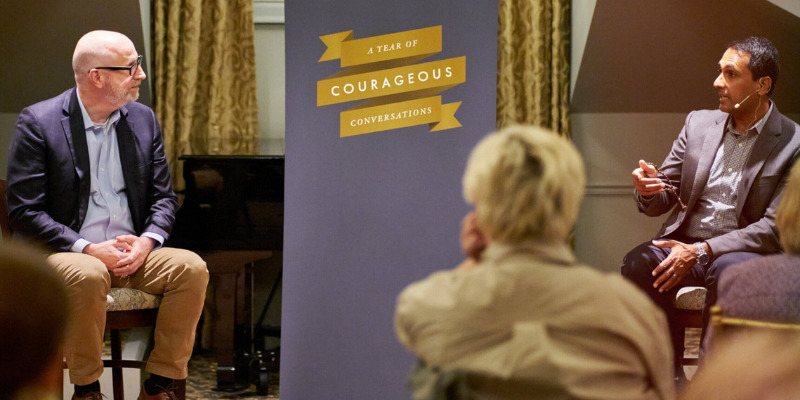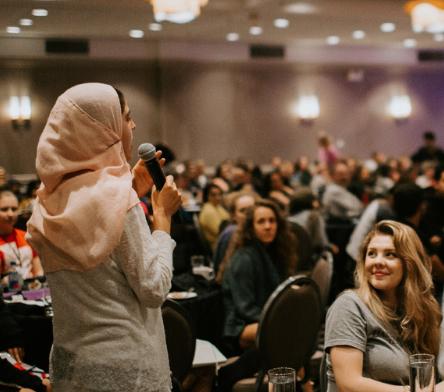From Interfaith Youth Core to Interfaith America
March 23, 2022

(On May 10, 2022, Interfaith Youth Core will become Interfaith America, with an expanded mission and vision. We look forward to all of our friends and partners joining us as we begin this new chapter. Interfaith America will launch on the same day as Eboo Patel’s new book, “We Need to Build: Fieldnotes for Diverse Democracy.” The launch coincides with a new PRRI/Interfaith America survey of American attitudes about our country’s growing religious pluralism. For more information contact Paul Raushenbush at [email protected])
“Eboo here has run off and joined the Flat Earth Society.”
It was the late 1990s and I was in my early 20s, hanging out with a group of school friends discussing dreams for the future. People talked about becoming professors, doctors, lawyers, scientists — the standard litany of high-achiever professional pursuits.
A different kind of dream was taking shape in my mind: starting a nonprofit organization called Interfaith Youth Core.
I had been taking frequent breaks from the doctoral dissertation I was writing at Oxford University to run projects that brought young people from diverse religions together to engage in social action and interfaith dialogue. It was work that fed my soul and that I believed could have a major impact in the world. Previous generations of faith-inspired young people – from the Rev. Martin Luther King Jr. to the Venerable Thich Nhat Hanh, Jane Addams and John Lewis – had shown the way.
My friends were not impressed. Cue the peals of laughter and snarky remarks. Didn’t I know that religion had gone out of fashion decades ago? Being called a flat-Earther is one of the more printable insults I received that night.
There was less laughter after George Bush became president of the United States, powered by religious rhetoric and evangelical Christian voters.
And after September 11, 2001, when a group of young extremists who claimed to be motivated by Islam attacked America, people started to say out loud that maybe I was onto something.
In a matter of months, religion went from being considered a preoccupation of people obsessed with the past to an issue at the center of every serious conversation about the future of humanity. And the role of faith-based young people was at the top of the agenda.
In that post-9/11 era, three basic approaches emerged. The “new atheists” claimed that the answer was to rid the world of religion. A second group was convinced that we were in the final battle of a civilizational war between “the West” and “Islam,” and the goal was to defeat the enemy once and for all.
Interfaith Youth Core was part of a third group, which pointed to a future where people of all religious and philosophical persuasions could thrive together. Following Harvard professor Diana Eck, we called this future pluralism, and defined it as a society that had:
- Respect for diverse identities
- Relationships between different communities
- Cooperation on projects that strengthened our common life together
Over the course of the 2000s, the youth movement Interfaith Youth Core was nurturing grew rapidly. Hundreds of people attended our national conferences and training events. Dozens of interfaith youth social action initiatives launched all over the country. We were profiled by major media, including The New York Times, CNN, National Public Radio and the Chicago Tribune. The Bush White House held IFYC up as a model. So did the Clinton Global Initiative, the Tony Blair Faith Foundation and the World Economic Forum.
Share
Related Articles
Higher Education
What Does Interfaith Engagement Mean from an Evangelical Perspective?
American Civic Life
New to Interfaith Work? Join the Emerging Leaders Mentorship Program
American Civic Life
Looking for Interfaith Mentorship? Join the Emerging Leaders Program

IFYC’s office in Chicago
The ethos of pluralism was gaining traction, and in 2008 it would culminate in the election of an American president who exemplified the spirit of pluralism in his speeches, his policy proposals, indeed his very being. Barack Obama took office speaking with pride about America’s patchwork heritage and promising to dissolve the lines of tribe. He had grown up in a nonreligious household, embraced Christianity as a young adult and spoke of his own faith as a bridge of cooperation rather than a barrier of division or a bludgeon of domination. And he was eloquent when he spoke of American religious diversity.
IFYC had a substantive relationship with the Obama White House. I was asked to serve on the President’s inaugural Faith Council and was part of meetings with Obama in both the Oval Office and the Roosevelt Room. We had a major partnership with the White House on a program called the President’s Interfaith Campus and Community Service Challenge, which involved over 500 colleges running interfaith service initiatives.
Our work at IFYC had grown beyond college students to programs that impacted entire campuses and higher education writ large. We were helping faculty design interfaith courses, working with administrations on interfaith strategic plans, running major research projects on religious diversity in higher education and receiving significant grants from entities like the Einhorn Collaborative, the Arthur Vining Davis Foundations, the Luce Foundation and the Lilly Endowment.
Along the way, I became a different kind of institutional leader. I had long thought that the role of great leaders was to galvanize crowds through inspiring speeches, and so I sought out stages and spotlights and did my best to deliver addresses that would rouse people to interfaith action. The problem was that there was a growing gap between the words I spoke and what the programs of the organization delivered.
A board member and mentor, Tarek Elmasry, noticed, and gave me the following advice: “Leaders are not judged by the speeches they give. They’re judged by the teams they build.” For Interfaith Youth Core to be more than a platform for my voice and a holding space for a set of scattered programs, I would need to turn my attention inward, and build the infrastructure of a proper institution. I write more about this process in my forthcoming book, “We Need to Build: Fieldnotes for Diverse Democracy.”
The train of interfaith cooperation ran into a brick wall called Donald Trump. His overt insults towards racial and religious minorities, coupled with the full-throated support his presidential campaigns received from white Christians, seemed to announce the end of the era of pluralism.
But if you study American religious history, you see that great progress on pluralism has often been made as a response to ugly prejudice. A powerful case in point: the National Conference of Christians and Jews, one of the most influential civic institutions of the 20th century. Later known as NCCJ, it emerged in the late 1920s largely as a response to the KKK and its hateful anti-Catholic, antisemitic and anti-Black campaigns.
The NCCJ was a powerful organization that over the course of decades ran a range of programs promoting “the brotherhood of man under the fatherhood of God.” Their most important contribution was to write a new chapter in the American story of religious diversity: Judeo-Christian nation.
It ought to be noted that the phrase Judeo-Christian is neither historically nor theologically accurate. Rather, it is a civic creation, virtually invented by the NCCJ, whose main purpose was to create a framework that allowed Catholics and Jews to claim a full place in the nation alongside Protestants.
The overt racism of the Trump era gave rise to an analogous realization for us at IFYC. While the term Judeo-Christian certainly helped improve the lot of Jews and Catholics over the past century, it did not include Muslims, Hindus, secular humanists and many others. It was an exclusion that proved easy to exploit by entrepreneurs of division and prejudice.
Over the course of the 2000s, the demographics of American religion changed dramatically. For generations, a miniscule number of Americans had checked the “none” box on surveys about religious identity. That category skyrocketed to over 25% of the nation. The number of Hindus and Muslims in the United States was growing rapidly too, and the median age of these religious groups was 20 years younger (mid-30s) than the median age of white Christians (mid-50s).
The murder of George Floyd during the summer of 2020 catalyzed a national reckoning around racism in particular, and diversity issues more broadly. IFYC started getting calls from companies like Starbucks and Salesforce, from government agencies involved in vaccine outreach, from major media interested in our views on the relationship between religious identity and other diversity issues. Were we prepared to move beyond our historic focus on young people and higher education to be part of the broader diversity challenges of the nation?
Over the 20 years of our history, we had steadily grown into the premier interfaith organization in the country. We worked with a network of nearly 600 campuses, employed over 50 full-time professional staff, and had an annual budget of approximately $15 million. Last year alone, we gave away nearly $5 million in grants to individuals, campuses and related organizations to support interfaith initiatives. Young people and higher education will always be one of the pillars of our work. Indeed, our programs with campuses and students are growing, exemplified by new partnership with Catholic and evangelical Christian college networks. But it is time for Interfaith Youth Core to fully embrace a wider role in American life: supporting people of all ages to be interfaith leaders and partnering with institutions from a range of sectors to be models of religious pluralism.

Eboo Patel, right, and Christian author David French in a “Courageous Conversations” Dialogue in September 2021.

IFYC’s Interfaith Leadership Institute (now named Interfaith Leadership Summit) in 2019. File photo
Over the past two years we have launched major initiatives in the areas of public health, tech, media, policy, racial equity and the private sector. Here are some examples of initiatives we are advancing:
- #Interfaith is a state-of-the-art curriculum which trains people to be interfaith leaders and bridgebuilders online.
- The Faith in the Vaccine Ambassadors program has trained and mobilized over two thousand individuals to be advocates for the vaccine within their own racial and religious community.
- The Building Civic Bridges Act is bi-partisan legislation that would establish an office of bridgebuilding within AmeriCorps.
- The Black Interfaith Project explores the religious diversity and interfaith cooperation within the Black experience. It recently launched in a program hosted by the White House, with Second Gentleman Douglas Emhoff as the featured speaker.
- We worked with Starbucks to develop religious diversity training that will be used by employees all over the country.
- The Vote is Sacred will demonstrate how a participatory diverse democracy is considered holy across religious traditions and mobilize college students to hold interfaith events that protect voting rights.
- Interfaith America media includes a magazine with original writing and reporting, a group of Media Fellows in partnership with Religion News Service and soon the Interfaith America podcast with Eboo Patel.
- Our “Scout” program will proactively seek out bridgebuilders who work within faith communities and give them specific interfaith leadership training and mini-grant to expand their initiatives.
- Our Evangelicals and Interfaith project highlights the Christian foundation for interfaith bridge-building, lifts up stories of evangelicals leading interfaith activities, and explores opportunities to strengthen evangelical involvement in interfaith partnerships.
- We partnered with the Association of Catholic Colleges and Universities to create a seminar on religious pluralism and racial equity for presidents of Catholic colleges and universities.
It is time for the United States to write the chapter after “Judeo-Christian” nation. And it is time for Interfaith Youth Core to enter its next phase too. How the United States engages its religious diversity will have huge implications for the future of our nation. Other great issues in American life – civil liberties, racial equity, environmental stewardship – have vital civic institutions whose mission is to engage that issue over the long run and steer it in a positive direction.
We view our role as being one of the vital civic institutions engaging the great issue of American religious diversity and steering it toward the positive outcome of interfaith bridgebuilding. We think the right name for both the next chapter in American religious history, and the next chapter for our organization is the same: Interfaith America.
We will know we have achieved Interfaith America when it is simply commonplace for cities across the country to have Days of Interfaith Service; when there is an established scholarly field called Interfaith Studies that certifies tens of thousands of people every year who have the knowledge base and skill set of Interfaith Leadership; when companies, schools, hospitals, and civil society organizations hire Interfaith Leaders because they recognize the significance of proactively engaging the religious diversity within their organizations; when houses of worship regularly have partnerships across faith lines; when people across traditions can readily articulate the theology or ethic of interfaith cooperation of their own community; when organizations across sectors view it as standard operating procedure to have interfaith strategic plans; when teaching the history of religious diversity in the United States is a robust part of every high school American history course. Most importantly, when religious diversity is understood as a powerful and visible asset that ought to be engaged positively and proactively rather than a dynamic that is either invisible or a threat.
Interfaith America the organization will devote its energies to serving as a catalyst, a resource, and a partner for building Interfaith America the nation. We delight in knowing that we walk this path with many others – college campuses, government agencies, houses of worship, civic groups, media organizations, private companies, other interfaith organizations and individuals of goodwill everywhere. The 21st Century American city on a hill has a steeple, a mosque, a synagogue, a sangha, a ward, a temple, a gurudwara, a secular humanist society and more. You and I are not just citizens of this city – together, we are architects of it. Now, let’s build.



